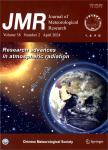Role of Differences in Surface Diurnal–Nocturnal Thermodynamics over Complex Terrain in a Squall Line Process
Role of Differences in Surface Diurnal–Nocturnal Thermodynamics over Complex Terrain in a Squall Line Process作者机构:Anhui Meteorological ObservatoryChina Meteorological Administration
出 版 物:《Journal of Meteorological Research》 (气象学报(英文版))
年 卷 期:2019年第33卷第1期
页 面:1-17页
核心收录:
学科分类:07[理学] 0707[理学-海洋科学] 070601[理学-气象学] 0815[工学-水利工程] 0706[理学-大气科学] 0816[工学-测绘科学与技术] 0824[工学-船舶与海洋工程] 0825[工学-航空宇航科学与技术]
基 金:Supported by the China Scholarship Council(201805330008) National Natural Science Foundation of China(1705029) Natural Science Foundation of Anhui Province(1808085QD118) Research Project Funds of Anhui Academy of Meteorological Sciences(KM201801)
主 题:squall line diurnal–nocturnal thermodynamic difference(DNTD) baroclinity complex terrain
摘 要:Squall lines frequently invade the Yangtze–Huaihe River region(YHR), where the complex terrain of rivers, lakes,and mountains plays an important role in the initiation and maintenance of convection. The surface heat flux not only varies with surface conditions, but also changes between day and night. Coupled with the terrain forcing, such diurnal–nocturnal thermodynamic differences shift the low-level baroclinity, and thus further complicate the convective activities. To investigate the integrated impact of diurnal–nocturnal thermodynamic differences on the development of squall lines over complex terrain including disasters that might ensue, numerical modeling experiments on a squall line in July 2014 were performed by forcing a squall line to pass the YHR separately at daytime and nighttime. The results show that the low-level instability during the day is much larger than that during the night, and is determined predominantly by the shortwave heating of the surface. Specifically, the solar radiation enhances the temperature gradient between the warmland ahead of the squall line and the convectively generated cold pool in the region around Chaohu Lake and the Yangtze River. Such low-level baroclinity sets preconditions in the environment towards the occurrence of deep convection. The increased precipitation and the evaporation of rain in the daytime also enhance the cold pool and the associated downdraft, which further intensify the squall line. Meanwhile, the valley breeze is intensified during the day. Such scenarios promote convection that extends the squall line and the associated heavy precipitation and wind gusts southward. This research may have significant implications for enhancing the squall line prediction capability in the YHR and improving our understanding of the physical mechanisms of convective activities over complex terrain.



